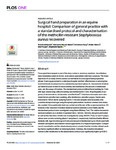Surgical hand preparation in an equine hospital: Comparison of general practice with a standardised protocol and characterisation of the methicillin-resistant Staphylococcus aureus recovered
Rocktäschel, Tina
Renner-Martin, Katharina
Cuny, Christiane
Brehm, Walter
Truyen, Uwe
Speck, Stephanie
Presurgical hand asepsis is part of the daily routine in veterinary medicine. Nevertheless, basic knowledge seems to be low, even among specialised veterinary surgeons. The major objectives of our study were to assess current habits for presurgical hand preparation (phase 1) among personnel in a veterinary hospital and their effectiveness in reducing bacteria from hands in comparison to a standardised protocol (phase 2). Assessment of individual habits focused on time for hand washing and disinfection, the amount of disinfectant used, and the usage of brushes. The standardised protocol defined hand washing for 1 min with liquid neutral soap without brushing and disinfection for 3 min. All participants (2 surgeons, 8 clinic members, 32 students) used Sterillium®. Total bacterial counts were determined before and after hand washing, after disinfection, and after surgery. Hands were immersed in 100 ml sterile sampling fluid for 1 min and samples were inoculated onto Columbia sheep blood agar using the spread-plate method. Bacterial colonies were manually counted. Glove perforation test was carried out at the end of the surgical procedure. Differences in the reduction of relative bacterial numbers between current habits and the standardised protocol were investigated using Mann-Whitney-Test. The relative increase in bacterial numbers as a function of operation time (≤60 min, >60 min) and glove perforation as well as the interaction of both was investigated by using ANOVA. Forty-six and 41 preparations were carried out during phase 1 and phase 2, respectively. Individual habits differed distinctly with regard to time (up to 8 min) and amount of disinfectant (up to 48 ml) used both between participants and between various applications of a respective participant. Comparison of current habits and the standardised protocol revealed that the duration of hand washing had no significant effect on reducing bacteria. Contrary, the reduction in bacterial numbers after disinfection by the standardised protocol was significantly higher (p<0.001) compared to routine every-day practice. With regard to disinfection efficacy, the standardised protocol completely eliminated individual effects. The mean reduction in phase 1 was 90.72% (LR = 3.23; right hand) and 89.97% (LR = 3.28; left hand) compared to 98.85% (LR = 3.29; right hand) and 98.92% (LR = 3.47; left hand) in phase 2. Eight participants (19%) carried MRSA (spa type t011, CC398) which is well established as a nosocomial pathogen in veterinary clinics. The isolates could further be assigned to a subpopulation which is particularly associated with equine clinics (mainly t011, ST398, gentamicin-resistant). Glove perforation occurred in 54% (surgeons) and 17% (assistants) of gloves, respectively, with a higher number in long-term invasive procedures. Overall, bacterial numbers on hands mainly increased over time, especially when glove perforation occurred. This was most distinct for glove perforations on the left hand and with longer operating times. Our results demonstrate that standardised protocols highly improve the efficacy of hand asepsis measures. Hence, guiding standardised protocols should be prerequisite to ensure state-of-the-art techniques which is essential for a successful infection control intervention.
Files in this item

